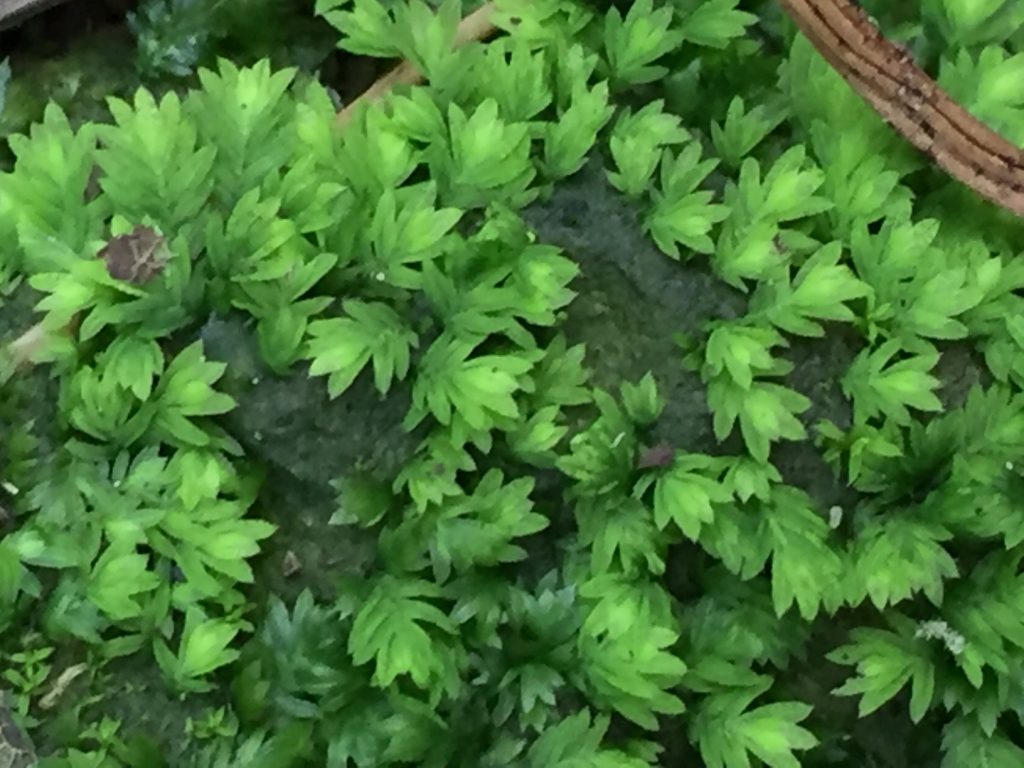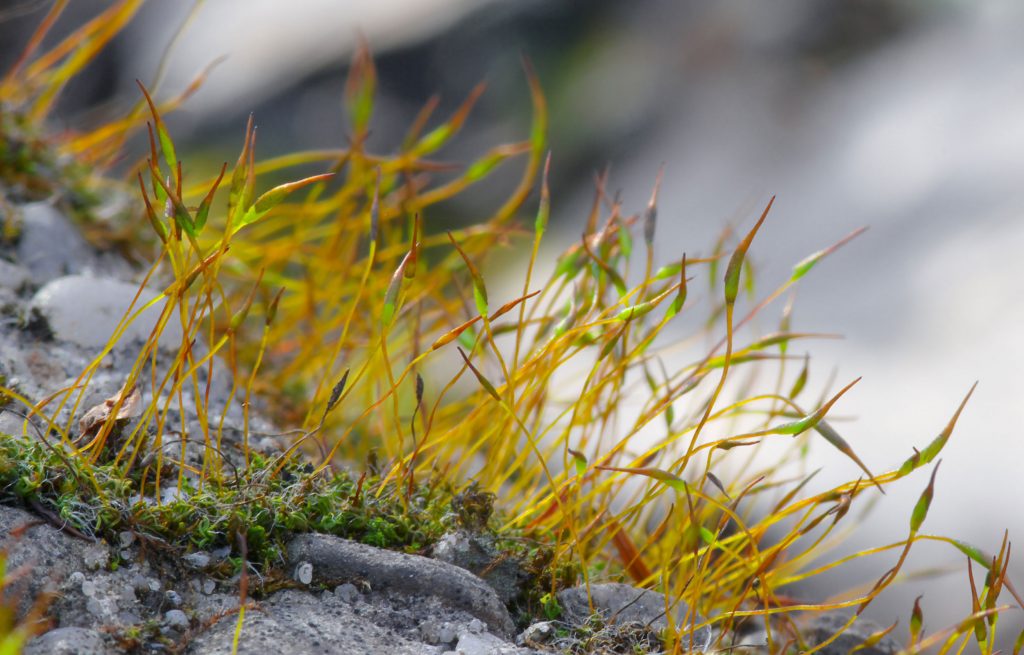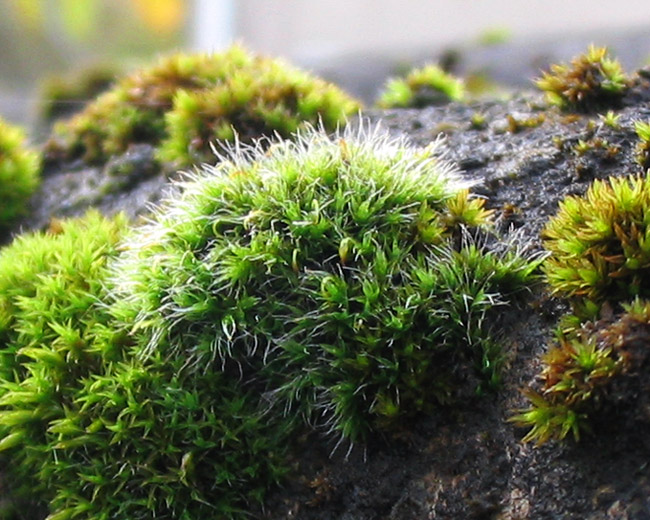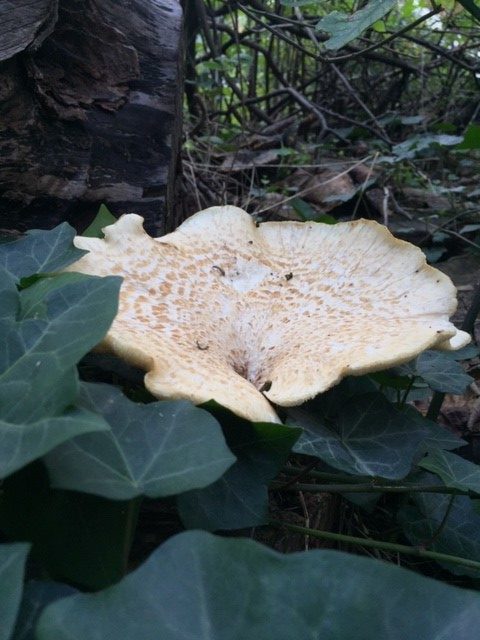I’m walking along the Nature Trail one morning. “Come on boys, concentrate!” shouts the football trainer from the park. For a moment I think he might be shouting at me, as my mind is wandering.
I have decided to have a look for some moss. I have been putting off my foray into the world of moss identification for some time. I bought a Field Studies Council laminated guide to mosses and liverworts last year, but a lot of them look rather similar. Nonetheless, I have the guide with me, and there is not much else about, so moss-hunting I go.
After a few minutes, I conclude that if you wanted to run a moss party on the Horniman Nature Trail you would struggle. All I have found is some green algae on a fence, which I don’t think counts as moss, although moss evolved from algae, so it’s sort of a moss-ancestor. Moss-ancestors do not feature in my guide though, so I must try harder. I eventually locate a green patch of leafy moss on a pile of logs, which if the guide is correct, looks like common pocket-moss (Fissidens taxifolius).

Pocket moss on the Nature Trail, Daniel Harwood
When I get home and double check on the Naturespot website, the photograph on the website looks like what I saw, but it has the ominous red camera logo beside the photo. This means something along the lines of ‘impossible to identify unless you are a Professor of Moss’. However, the accompanying description says the “nerve” (the central leaf vein on a moss is called a nerve rather than a midrib) is, “excurrent and protrudes as a short point”.
Well, my plant has a nerve that sticks out a bit at the end which I assume is what that means, so I am calling my moss common pocket-moss, and it’s going on the list.
Moss, like lichen, is difficult.
There is a reason, after all, why there are more birdwatchers than mosswatchers. Later, I look up the British Bryological Society (BBS) website. Bryophytes is the name given to the group of plants include mosses, liverworts and hornworts. The website’s introductory page starts like this,
Because of their unassuming nature and small stature, bryophytes are easily overlooked or even dismissed as boring, but their beauty and complexity under the microscope easily puts them on a par with their higher plant relatives.
The website has a well-written introduction to bryophytes, and more importantly for you and I, some good clear tips for beginners.
Bryophytes are a crucial and central part of our country’s flora. Only one fifth of the total number of European species of vascular plants (trees, flowers and grasses) live in the UK and Ireland. Whereas for bryophytes, 58% of the European species make their home here. Bryophytes like it here, because it is damp and warm.

Tortula muralis – commonly seen on the tops of brick walls, everywhere (but not on the Nature Trail!), Kruczy89 via wikicommons CC BY-SA 3.0
Despite this, according to my son who attended a talk by a British bryologist, it is hard to enthuse young botanists in bryology – and hard to convince British universities they should be running courses on bryology within their Botany departments.
This is very sad but does not surprise me. British people understand the importance of the tropical rainforest, but not our own Atlantic rainforest with all its mysterious ferns and bryophytes. Even the poor British Bryological Society have to admit that bryophytes are dismissed as boring. They need to be more positive!
There are 1,000 species of bryophyte in the UK and Ireland.

Bryophytes photosynthesise, which means that they can make sugar from sunlight with the help of chlorophyll (the green pigment in plants, which does not occur in fungi). That means that, like other plants, but unlike fungi, bryophytes are green.
Flowers and trees have roots, and firm stems which means they can stand upright, and they have a vascular system. This means tubes inside the plant can transport water and minerals up from the roots, all round the plant, and move nutrients like sugar from the green leaves where it is made (by photosynthesis) to all other parts of the plant.
Bryophytes have no proper roots, no vascular system and no firm stem. That is why they are small, low and floppy.
Because bryophytes have no vascular system it also means they cannot shift water up from the soil and distribute it around the plant, and so they dry out easily. Many of the leaves are very thin, just one cell thick, which means they can absorb water quickly from their environment but also that they dry out fast. When dry, they enter a state of dormancy but can be revived with a soaking.

Grimmia pulvinata – another common urban moss seen on walls, often bluish grey, Darkone via wikicommons CC BY-SA 2.5
Their leaves are often intricate and complicated, to maximise the area for photosynthesis, optimise water absorption and minimise water loss. This means that under the hand lens or microscope you can see their exquisite shapes, they are genuinely jewel-like with the most gorgeous patterns.
One of the facts I found most astounding about moss is that moss sperm, which is produced in a structure called the antheridia, has little flagellae, rather like mammalian sperm. It actually swims through a film of water on the moss plant to the female sex organ, known as the archegonia, where fertilisation takes place and spores produced. At school we were taught plants cannot actively move, well, moss sperm can.
The fertilised spores sit on structures called sporophytes, which look a bit like antennae, and stick up out of the carpet or cushion of and release their spores, when conditions are dry. You might have even noticed these little sporophytes protruding from moss cushions on walls and pavements near where you live.
There are three types of bryophyte; moss, which you are probably at least vaguely familiar with, liverworts, which are leafier and can look like a mass of flattened tissue, and hornworts, which are rare, look a bit like moss but have reproductive parts which look like horns.
Bryophytes have in the past been thought of as ‘primitive’ plants. But they have been on this planet for around 500 million years, which means they are resilient, and able to adapt and find new niches to live. How long will humans be around? 600 million years? I doubt it.
Tips for enjoying bryophytes
- Look in damp places – by lakes or rivers, in woodland, or in marshy areas. But they are not that fussy and can occur in lots of places; walls, lawns, fields, garages and more.
- If you want to see them at their best, visit after rain. But if you find one dried out, you can liven it up by pouring water on it.
- You do need a hand lens to identify most of them, and the BBS recommend a high magnification one if possible (15 or 20 times magnification)
- Use the BBS website to get started, which has a downloadable leaflet on the Mosses and Liverworts of Town and Garden, and some good introductory reading. The Field Studies Council fold out guide is good too.
Lastly, just to remind you it’s fungi season on the Nature Trail, here’s a splendid Dryad’s saddle (Cerioporus sqaumosus), I found. Keep your eyes open and enjoy the trail!

It’s mushroom season on the Nature Trail. Spot ones like this dryad’s saddle, Daniel Harwood
References
Wildlife Shop – Field Studies Council
Recording the Wildlife of Leicestershire and Rutland | NatureSpot


